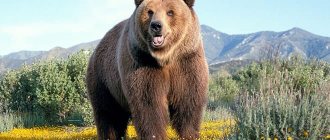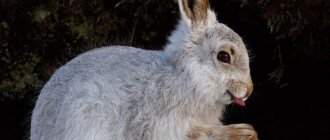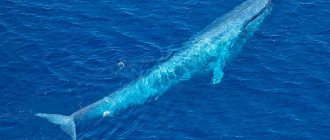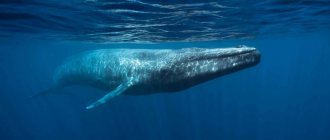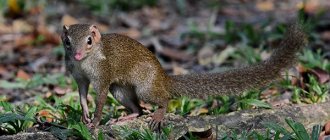Home > Alphabetical guide > > White-bellied lizard
White-bellied pangolin (white-bellied pangolin)
- the smallest representative of the mammals of the pangolin order, inhabiting Central and Western Africa.
Habitat
. The white-bellied lizard's natural habitat is a large area of Western and Central Africa, from western Kenya and southern Zambia to Senegal.
Unpretentious animals of this species settled in their habitat not only in low-lying tropical forests with a humid climate, but also in savannas and cultivated lands.
White-bellied lizards inhabit the tropical forests of Central and Western Africa. White-bellied pangolins are usually nocturnal, moving mainly on four limbs. They can, of course, walk on their hind legs, controlling their balance with the help of a large and powerful tail. They have very poor eyesight, which is more than compensated by a well-developed sense of smell.
Description
. White-bellied lizards are one of the smallest representatives of their species. Their dimensions are relatively small: weight - 1.81–2.4 kg, while the body length ranges from 350 cm to 450 cm. But the length of the animal’s tail can reach 0.5 m. And despite their relatively small size, animals of this species are able to protect themselves from danger with the help of a protective scaly body cover. In addition, unlike other representatives of lizards, white-bellied pangolins have spines on their scales, which are especially noticeable on the back. Another feature of these representatives of the pangolin order is a forty-centimeter tongue and enlarged salivary glands, which have a specific honey smell to attract termites and ants. The belly itself and its hairline of the pangolin are white, which actually served as the reason for the name of this species.
Nutrition
. The main diet of white-bellied foot-and-mouth disease consists of termites and ants. In the most critical situations, animals of this species can feast on other insects living under the bark of trees. In ordinary situations, white-bellied pangolins cling to tree branches with their powerful tails, destroy insect shelters with their front paws with long claws and catch them using their long tongue. The daily food intake for an animal of this species is up to 200 g of “live food”.
Social behavior
. As for behavior in their natural habitat, white-bellied lizards are territorial animals. Each of the representatives of this species, regardless of gender, leads a solitary life exclusively on its own territory. Moreover, the female’s area is about 40 km2, and the male’s is up to 200 km2.
Description
The bodies of these animals are covered with hard, overlapping scales of keratin and sparse hair. The name "pangolin" comes from the Malay word pengguling, which means "one who curls up into a ball." When attacked, pangolins curl up into a ball and, covering their heads with their tail, turn into an impenetrable armored ball. In addition, their scales have razor-sharp edges, and scratching them can cause serious cuts to the animal.
Steppe lizard (Smutsia temminckii) curled up in a ball
In size, different types of pangolins reach from 30 cm to 1 m in body length (without tail), females are slightly smaller than males. The body is elongated, with short legs, a small head with an elongated muzzle and a large nose, small eyes and almost invisible ears. The scaly tail is almost equal in length to the body (longer in the long-tailed lizard) and wide, since its main purpose is to cover the poorly protected area of the abdomen and head when the animal curls up in a ball. In fact, in some species the number of caudal vertebrae reaches 47, which is a kind of record among mammals. In addition, most tree species have a prehensile tail, i.e. it can twine around branches and serve as a fifth limb. Lizards have long, curved and strong claws, especially on their front feet, which help them climb, tear off bark and dig in the ground in search of food. Terrestrial species walk with their long claws on their front feet tucked in so that they do not get in the way or get worn down.
Long-tailed lizard
Pangolins have an extremely long, flexible and sticky tongue, with which they catch insects (mainly ants and termites) that penetrate deep into their passages, like anteaters. This unique tongue is not attached to the hyoid bone, but an extension of its base extends into the chest cavity, between the sternum and trachea. Large lizards can extend their tongue up to 40 cm in length with a thickness of 0.5 cm. They also have a huge salivary gland in the chest, which secretes sticky saliva necessary for hunting ants. These animals have no teeth and do not chew their food. Therefore, in the stomach they have a special compartment covered with a cornea and even corneal teeth for grinding solid food, which is also helped by sand and pebbles swallowed by the animal (similar to birds).
Indian pangolin
Another feature of lizards is that near their anus there is a special gland that secretes an odorous secretion for protective purposes, like skunks.
Although they appear primitive, pangolins actually have a highly developed part of the brain associated with finding solutions. They are excellent at finding food and choosing a defensive response against various predators, and in captivity they become extremely resourceful escapees.
Javan lizard
Interesting facts about Pangolin - an amazing lizard with unique armor
The animal I'm going to tell you about today is a myrmecophagous animal - an animal that eats only ants and termites. However, this is not the most surprising difference from other animals. They are perhaps the strangest looking mammals out there - like a quirky little herbivorous dinosaur or a giant earless mouse with frighteningly hard skin. In my opinion, they look like a craft made entirely from a pine cone, and also look like a “revived artichoke.” Today, a huge number of poachers hunt for pangolins.
Native to Asia and Africa
There are eight species of pangolin - Chinese pangolin, Indian pangolin, Sunda pangolin (also known as the Malayan pangolin), Philippine pangolin, giant pangolin, white-bellied pangolin (which includes the long-tailed pangolin), black-bellied pangolin and Temminck's ground pangolin (also known as the Cape pangolin ) - half of them come from Asia, while the others live in Africa. Although they resemble anteaters and armadillos, they are actually more closely related to cats and dogs, although they are completely toothless.
These solitary animals spend their nights lounging around, sniffing ant mounds with their sensitive noses, and using their long, sticky tongues to capture insects. The pangolin's thin, flexible tongue is truly a miracle - it is often longer than the animal's entire body. When not in use, they keep it rolled up in a small chamber between the last ribs and the pelvis. Some pangolin species also consume rocks (called gastroliths) and sand to break down prey in their stomachs.
The pangolin's thin, flexible tongue is truly a miracle - it is often longer than the animal's entire body.
Pangolins are usually quite slow, although they can speed up quickly when necessary, and they have poor eyesight. But when they find themselves under the gun of a predator, they have their own defense strategy. For example, a predator might get a foul-smelling substance in the face, which pangolins use to mark their territory.
However, the best weapon the pangolin has is that it can turn into a real puzzle ball. Pangolins are protected by a shell of thick keratin scales that are so strong that they can withstand a lion's attack - they simply curl into a small ball like a hedgehog and can withstand all types of blows.
In fact, pangolins are the only scaly mammals, and these keratin plates grow throughout the animal's life, much like hair. They periodically grind down while the pangolin goes about its business, digging holes and making its way through tunnels. However, the animal is not completely covered in scales - their bellies are bare, except for an area with a small amount of fur.
Although pangolins are unassuming and docile, several species play important roles in their ecosystems. There's still a lot we don't know about pangolins, but they definitely keep ant and termite populations in check. Different species prefer different types of habitat - some, like African black-and-white-bellied pangolins, are arboreal, so they use their long claws for climbing and use hooks and tree cavities for shelters and sleeping quarters.
Other pangolin species spend their entire lives on the ground, digging burrows and foraging for insects. In fact, it is their scratching and digging that makes them important members of their ecosystems—they aerate the soil (which promotes nutrient cycling). And pangolin burrows can be home to many other animals - some of them large enough for a person to crawl through.
The most sold animal in the world
Life for a pangolin is hard enough. It is estimated that pangolins make up about 20 percent of the global black market for wildlife, and about 2 million animals are poached each year. They are a traditional source of meat in many parts of Africa and are considered a delicacy in parts of Southeast Asia (mainly because they are difficult to find and very expensive - the meat is reportedly not very tasty), but it is pangolin scales that attract poachers the most .
It is used in traditional Asian and African medicines to treat many types of ailments (from heart disease to cancer), even though they are simply made from keratin, the same thing your hair and nails are made from.
Although pangolin scales have been used in traditional medicine for centuries, there is no scientific evidence to support claims that they have medicinal value. However, the Asian market is experiencing a shortage of pangolin scales, and illegal trade is thriving on a huge scale, despite strict international laws prohibiting poaching.
Illegal trade has already caused significant population declines in four Asian pangolin species, two of which (Chinese and Sunda) are currently listed as critically endangered. Due to this decline in numbers, as well as increasing trade links between Africa and Asia, African pangolin populations are increasingly being poached and smuggled into Asia.
Pangolin conservation
In 2016, all eight pangolin species received stricter protections under the Convention on International Trade in Endangered Species (CITES), which prohibits all commercial trade in wild-caught pangolins worldwide. The law came into force in January 2022, and since then large quantities of pangolin products have been seized throughout the animal's range in Asia and Africa.
It is difficult to assess whether stricter protections are helping wild pangolin populations because so little time has passed since the ban was introduced. It is also difficult to draw conclusions for the reason that females give birth to only one cub per year.
Important
One of the threats to the Temminck's ground pangolin is electrocution on fences that are energized. One study found that mortality rates for Temminck's ground pangolin could be as high as one individual per 11 kilometers of electric fence per year in southern Africa.
SOURCE
Lifestyle and nutrition
Pangolins, with a few exceptions, are active at night, relying primarily on their good sense of smell to find food. When they find an anthill, they dig it up with strong claws and lick off the ants and their larvae, because they are protected from bites by their armor. Tree species, in turn, search for insects by tearing off tree bark. During the day they sleep, curled up in a ball, in thickets, hollow trees or underground burrows. Earth lizards are capable of digging their own holes, but usually use abandoned warthogs or aardvarks' lairs. Pangolins are also excellent swimmers.
The white-bellied lizard lives in trees
White-bellied pangolin Manis tricuspis
7872
7873
7874
7875
7876
7877
7878
7879
The white-bellied lizard (Phataginus tricuspis) is listed as “vulnerable” on the IUCN Red List of Threatened Species.
Reproduction
After 120–150 days of gestation, female African pangolins give birth to one baby at a time, while female Asian pangolins give birth to one to three. The scales of newborns are soft and harden with age. The young of terrestrial species remain in the den for the first 2–4 weeks of life, whereas in arboreal species the mother carries the young clinging to her tail. Young pangolins feed on milk until about three months, and reach sexual maturity at 2 years of age.
Female Philippine pangolin (Manis culionensis) with calf
Appearance
The white-bellied pangolin, or white-bellied pangolin (Manis tricuspis) is the smallest species of pangolin: its body length ranges from 37 to 44 cm, tail length from 40 to 50 cm, weight varies from 1.8 to 2.4 kg. The upper side of the head, back, sides, outer surface of the limbs, as well as the tail of the white-bellied lizard are covered with scales. It is colored from brown to dark brown. On the loose edge, each scale has three clearly visible points (hence the origin of the species epithet tricuspis). In older animals, the dots fade. Unlike other representatives of the order, white-bellied pangolins have spines on their scales, which are especially noticeable on the back. Another feature of white-bellied lizards is their forty-centimeter tongue and enlarged salivary glands, which have a specific honey smell to attract termites and ants. The skin visible on the unprotected belly is white, which gave rise to the name of the species.
Pangolins and humans
In Africa and China, the meat of these animals is highly valued by the local population. In addition, the Chinese believe that pangolin scales help relieve swelling, improve blood circulation and increase the amount of breast milk. In addition to hunting, pangolins are threatened by deforestation, and representatives of African terrestrial species often die from forest fires. In 2022, there was speculation that pangolins are a potential intermediate host for the novel coronavirus SARS-CoV-2, which causes the disease COVID-19.
Pangolin scales confiscated from poachers in Cameroon
Habitat and lifestyle
' range of the white-bellied pangolin extends from Senegal to western Kenya and south to Zambia. The lizard lives in lowland tropical rainforests (primary and secondary), savannas, and also on cultivated lands. It leads a predominantly arboreal and nocturnal lifestyle. The white-bellied pangolin is a good tree climber. The tip of its already tenacious long tail is devoid of scaly cover, which further increases its tenacity. During the day, lizards rest in hollow trees, among epiphytes, and in excavated termite mounds. They are territorial animals. Each of the representatives of this species, regardless of gender, leads a solitary life exclusively on its own territory, with the area of the female’s territory being about 40 km2, and the male’s up to 200 km2. African lizards mark territory using secretions from the anal area. Females rarely meet each other because their territories do not overlap. The territories of males overlap the territories of several females. Males and females regularly meet for short periods of time, especially when females are in rutting season.
Appearance of the mammal pangolin
In this animal, during the process of evolution, the fur turned into ossified horny plates.
Adult pangolins grow up to 80 centimeters in length (excluding the tail, with a tail - twice as long). The weight of an average animal is from 5 to 27 kilograms. The entire body of the pangolin, with the exception of the abdominal part, muzzle and paws, is covered with amazing calch-like diamond-shaped scales. All parts of the body not protected by armor are overgrown with coarse hair. The “armor” scales have amazing restorative properties: as they wear out, new ones grow in place of the old ones.
The paws are five-fingered, equipped with massive claws, allowing them to dig the ground with ease. The animal's eyes are small, they are protected by thick-skinned eyelids. Pangolins have a surprisingly long tongue. I wonder why the beast needs it? Maybe for food? The animal has almost no teeth, since the pangolin absorbs food without chewing it.
With this tongue you can not only tease, but also catch insects in their burrows and hollows.
Pangolin breeding
The mating season occurs once a year. Gestation of the baby lasts about 4 – 5 months. One female gives birth to one baby, its weight is approximately half a kilogram. When a baby pangolin is first born, its scales are pink and soft in texture, hardening within a few days. The body itself is pink, not covered with hair.
After birth, the baby feeds on mother's milk, and after a month, begins to eat insects.
This photo shows a mother pangolin with her baby. The baby's plates are still very soft and pink.
What does a pangolin eat?
It turns out that the animal really needs a long 40-centimeter tongue to get food. With it he gets termites and ants, which are the main food for the pangolin. In addition, the animal’s saliva has a pleasant smell for insects, which literally attracts various bugs and moths to the pangolin like a magnet and makes them “dinner” for the animal.
Curling up into a ball, the pangolin becomes inaccessible thanks to its armor.
Pangolin lifestyle
These mammals from the order of pangolins prefer to occupy open areas. They also love to live in tropical forests. Thanks to its claws, the pangolin not only digs well, but also skillfully climbs trees.
The animal walks very slowly, sometimes it can walk for some time on its hind legs. Pangolins are characterized by a nocturnal lifestyle, and during daylight hours they usually hide in their deep burrows or tree hollows.
Not only strong paws with claws help him climb trees, but also a powerful, tenacious tail.
These animals cannot boast of good eyesight and hearing. But their sense of smell is simply excellent! Sensing the approach of danger from afar, the animal curls up into a strong ball, which almost no one can untwist. Pangolins also defend themselves by emitting a very unpleasant odor. All this makes the pangolin almost invulnerable. He has no enemies in nature.
Economic importance
People's interest in these animals is caused not only by the gastronomic qualities of the meat, which is similar to pork, but also by their unusual scales, which are used in souvenirs. Locals on the island of Borneo make something like magical talismans from pangolin scales, believing that they protect against disease.
The powerful tail allows the pangolin to hang upside down. Paws are free to catch insects.
If you find an error, please select a piece of text and press Ctrl+Enter.
